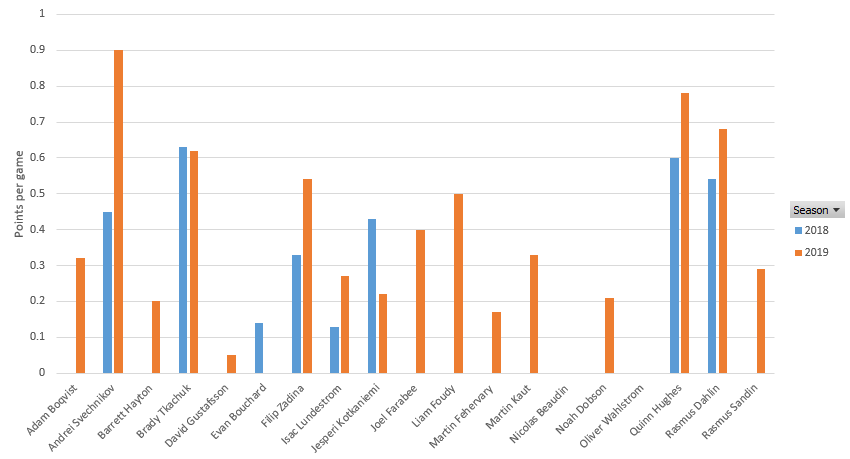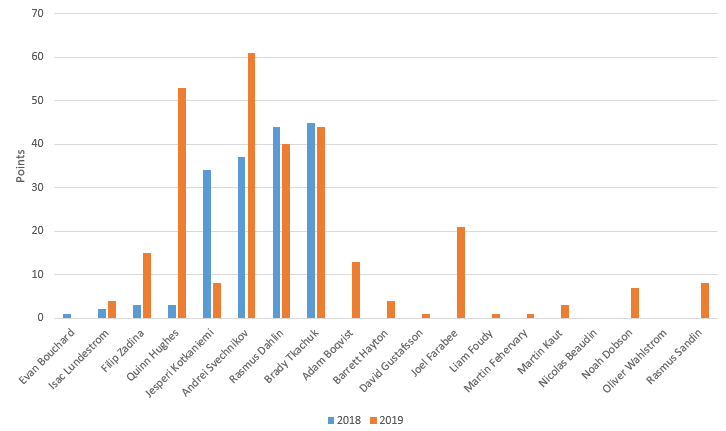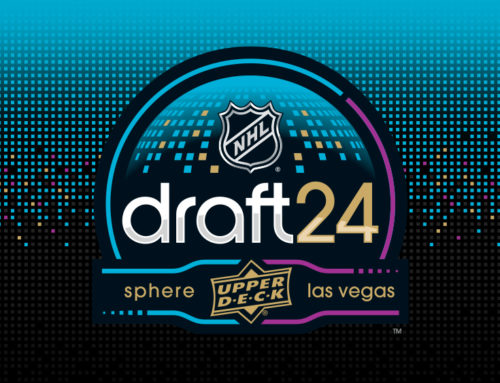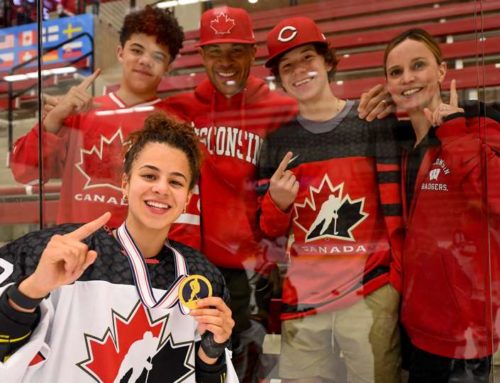Prospect Ramblings: What to Expect from the 2019 Draft Class
Brayden Olafson
2020-08-14
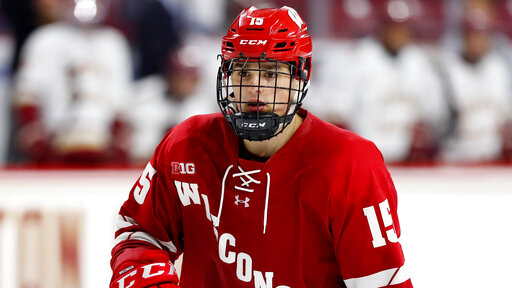
Wisconsin’s Alex Turcotte during an NCAA hockey game against the Boston College on Friday, Oct. 11, 2019 in Chestnut Hill, Mass. (AP Photo/Winslow Townson)
To date, seven of the two-hundred and seventeen players selected in the 2019 NHL Entry Draft have earned time in the big league. Of the seven, only one – Toronto’s Nick Robertson, was selected outside of the first round.
In comparison, at this time last year just one more, for a total of eight players from the 2018 NHL Entry Draft had been given the opportunity to suit up in the NHL. Stepping back yet again, at this time two years ago, eleven players from the prior draft had played NHL games. (Disclaimer: These totals include players who only played in either the regular season or playoffs)
Now of course this is far too small of a sample size to conclude that there is a trend of NHL front offices becoming more patient with prospects (although I wouldn’t rule that out), and truthfully that’s not where this is going at all, at least for this week’s Ramblings. Rather, what I want to illustrate is that as of late, only 3% to 5% of drafted players will be blessed with even a sniff of NHL opportunity in the 365 days that follow their selection. Now, if we fastforward another 365 days, what do the results look like?
For the 2017 draft, an additional 14 players dressed for NHL games in their D+2 season, while one of the players who had dressed in his D+1 season failed to return for any games (Owen Tippett).
Of those 14 who stepped in for their rookie season, five ended up scoring more than 10 points, while three exceeded the 30-point threshold.
Those players who returned for their sophomore season averaged an increase in point production of 228%, although average scoring rate was largely flatlined from their rookie seasons. Dips were seen in production by Nico Hischier (52 points to 47 points) and Kailer Yamamoto (3 points to 2 points), while massive dips in scoring rate were observed in Lias Andersson and Casey Mittelstadt.
For the 2018 draft, an additional 11 players dressed for NHL games in their D+2 season, while one of the players who had dressed in his D+1 season failed to return for any games (Evan Bouchard)
Of those 11 who made their debut in 2019, only two exceeded the 10 point mark, although both Martin Kaut and Rasmus Sandin posted decent scoring rates at 0.33 points per game and 0.29 points per game, respectively.
More notably, the players who returned for their sophomore and D+2 season in 2019 grew in terms of total point production by an average rate of 355%, and scoring rate by 122%. The most notable uptick was seen by Andrei Svechnikov who doubled his scoring rate from 0.45 points per game (37 points) to scoring at a rate of 0.9 points per game for a total of 61 points this year. In addition, Filip Zadina, Isac Lunderstrom, Rasmus Dahlin and Quinn Hughes all improved in terms of their scoring rate.
Now most importantly, how can we use this information to look forward to the 2020-21 season? There really isn’t much of a regional/geographical correlation with the players who have been able to make the jump in their second year after being drafted – development is an individual trait and while some leagues might be better at developing certain players, it doesn’t seem logical that there would be a one-size-fits-all league to develop the players who are on the fringe of being ready.
There is one obvious trend through – of the 25 players who made NHL debuts in their D+2 season, a whopping 88% were chosen in the top 22 selections of the draft, and the only anomaly who was selected outside of the top-24 was… Ottawa’s Drake Batherson who was chosen 121st in 2017.
With this in mind, I think that it’s very safe for us to assume that of the 10-15 odd players from the 2019 Entry Draft who might step into the NHL next season, all will be from the first round, and only three or four should be expected to make contributions that could be considered “significant”
Of the 25 players from the first round of the 2019 draft who have not yet played an NHL game only 8 remain unsigned. Of those who are still unsigned (Vasili Podkolzin, Matthew Boldy, Spencer Knight, Cam York, Cole Caufield, Alex Newhook, John Beecher & Ryan Johnson), most will likely remain unsigned and make an attempt to return to the collegiate circiut if and when their respective conferences resume play, or in Podkolzin’s case, remain in Russia.
That leaves only a select group of players who seem to have a legitimate shot at getting into the league next year, so while you might be thinking that 15 of those 16 players will slot in as your fantasy flagship this ~Fall~, I’m here to tell you to scale back your expectations!
While any of Dylan Cozens, Peyton Krebs, Lassi Thomson, Simon Holmstrom, Philip Tomasino, and Jakob Pelletier seem to be on the fringe of making a case for an NHL job, I wouldn’t be prepared to bet on any of them to have any kind of a significant impact OR fantasy impact by this time next year
On the other hand, here are my choices for the 2019 draftees who I expect to have the most significant fantasy impact in the 2020-21 season…
Alex Turcotte, LAK
The Los Angeles Kings have widely been advertised as the NHL team who currently boasts the strongest pipeline – and those advertisements are bang on. Atop the mountain of skill and potential in LA is the quietly extravagant centerman Alex Turcotte. After only a year at the University of Wisonsin, Turcotte’s patience was seemingly expired – and who could blame him?
After being overshadowed by his former USNTDP teammate at the World Junior Championships, Turcotte absolutely has something to prove. Despite some less than impressive box score statistics at the WJC, there is so much more to Turcotte’s game that remains to be seen on the national stage.
In addition, the lack of NHL caliber depth in LA’s system could absolutely allow for Turcotte to quickly leapfrog Blake Lizotte for the third-line center gig, and sneak up on Gabe Vilardi who has only proven himself on a small sample size.
Trevor Zegras, ANA
The shifty and elusive Zegras is a tantalizing player at the worst of times. At the best of times, he’s a meticulous magician with the puck who can out-edge, out-pass and outsmart his competition. Overall, he presents toolkit that is a recipe for offensive success and is no doubt prepared to take the next step. While there will undoubtedly be some growing pains for Zegras as he transitions to a league with players who possesses a higher defensive aptitude and a more daunting physical presence, his innate intelligence with and without the puck will give him a leg up on other young and inexperienced players in the NHL.
Although I might not expect immediate production from the one-and-done collegiate forward, I would be surprised if we don’t see a comfortable and confident Zegras emerge in Anaheim by the 20-game mark. As optimistic as I am for Zegras to have an impactful rookie season next year, I’m even more excited for what he’ll be able to do after a year of experience in the league. He’s a must-own on fantasy keeper teams and absolutely worth a gamble in new dynasties or one-year leagues.
Victor Soderstrom, ARZ
After trading up to select Victor Sodertrom a year ago, John Chayka is out in Arizona. Fortunately, it will be difficult for the remaining brass to deny what the 19-year-old has accomplished since being selected 11th overall.
The ‘Yotes have already signaled that the defenseman could be a potentially impactful player by including him on their bubble-roster for the Stanley Cup playoffs. As a black ace, Soderstrom could potentially be called upon yet this season in fact.
Although Arizona is currently both on the hook for six legitimate NHL defenseman contracts, bottoming out at Jordan Osterle, plus another few bubble defensemen in Ilya Lyubushkin, Aaron Ness and Kyle Capobianco, the core of that group has a history of fragility.
Considering that the team is currently in a favorable position, defensively, to support him it seems like good timing to allow him to bypass the AHL, and continue playing his style of game. With Soderstrom making such a suitable case for his NHL readiness in the SHL, it would be surprising for him to not have a fair shot at making the team anyways.
Connor McMichael, WAS
Another of the NHL bubble’s black aces is the Washington Capitals 25th-overall steal, Connor McMichael. The London Knight’s forward was dominant for Canada at the World Junior Championship and demonstrated an offensive technical aptitude that had been totally unbenknownst to me.
The strength of his tactical characteristics give me the sense that where McMichael begins in the NHL will be only a fraction of where he ends up. Although I wouldn’t anticipate much more than a 30-point rookie season from him next year, if he is in fact able to earn a roster spot, I believe that over the course of the next 2-3 years, he will have the ability to become one of the Capitals most effective offensive players, especially considering what resources the team will be able to surround and support him with in the years to come.
***
@olaf1393




